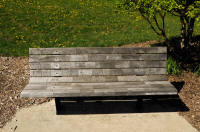 People spend a lot of time choosing
the right couch and end tables for their living room but
might buy the first wooden bench they see to place in
their landscape. To get the most from your landscape
furniture, it should be chosen and placed with the same
intent and consideration as if you were adding an
ornamental tree to your yard.
People spend a lot of time choosing
the right couch and end tables for their living room but
might buy the first wooden bench they see to place in
their landscape. To get the most from your landscape
furniture, it should be chosen and placed with the same
intent and consideration as if you were adding an
ornamental tree to your yard.
Furniture in the garden can serve
many purposes. It is a place to sit and enjoy the
outdoors while reading a book. It can be a place to have
a nice meal or play with your grandchildren. Furniture
can provide a place to rest while you are hard at work
with your plants.
However, whatever
the practical, utilitarian purpose the furniture in your
garden, it must also fulfill a design purpose too. The
same design criteria used to determine how to best
display your plants should be applied to the placement
and style of your garden furniture. A very formal bench
in an informal garden will stand out like a sore thumb.



